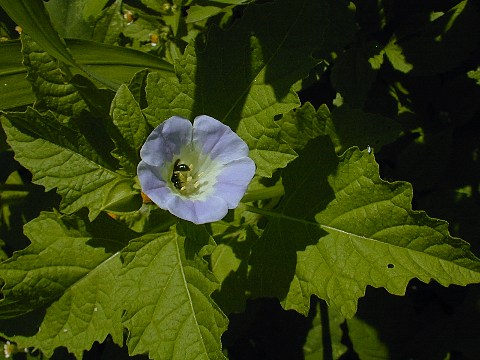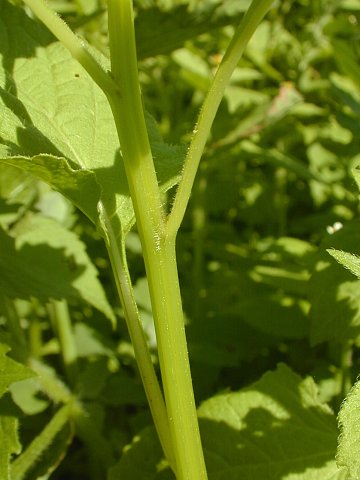Description: This plant is a summer annual that becomes 2-5' tall, branching occasionally. The stems are angular and largely hairless. The alternate leaves are up to 8" long and 4" across (excluding the petioles). They are ovate-cordate and sparsely pubescent. Their margins are shallowly lobed, bluntly dentate, or undulate. The petiole of each leaf is long and slender, tilting at an upward angle; there are a few hairs near its base, otherwise it is hairless. From the axils of the upper leaves, there develops individual flowers on short stalks. These flowers often nod downward, but are sometimes erect. Each flower consists of a spreading corolla that is light blue or lavender with 5 shallow lobes. However, the throat of the corolla is white, where there are 5 stamens with light yellow anthers and a single pistil. These flowers are about 1–1½" across when fully open; they are diurnal and short-lived. The blooming period occurs during the summer and lasts about 2-3 months. Only a few flowers remain open at the same time. The calyx is shorter than the flowers and divided into 5 sepals. Each sepal is ovate-sagittate. After the flowers wither away, spheroid fruits develop within the enclosing sepals of the calyx. This fruit is about ½" across and divided into 5 cells (sometimes only 3-4 cells). It has a dry texture and is full of seeds. The root system consists of a taproot. This plant spreads by reseeding itself.

Cultivation:
The
preference is full or partial sun, moist to mesic conditions, and a
loamy fertile soil. Most vegetative growth occurs during the late
spring and summer; this species is a summer annual. The size of a plant
is variable, depending on soil fertility and availability of moisture.
Range & Habitat:
The Shoofly Plant is an uncommon plant that has naturalized in
scattered counties throughout Illinois, except the NW area of the state
(see Distribution
Map).
It was introduced into the United States from tropical America as an
ornamental plant. Habitats include areas adjacent to flower gardens,
areas along roadside ditches, cropland, and fallow fields. This species
is occasionally cultivated in flower gardens because of the moderately
attractive flowers. It prefers disturbed areas, and usually doesn't
persist in the wild.
Faunal Associations:
The nectar and pollen of the flowers attract various kinds of bees.
Like other members of the Nightshade family, the foliage is toxic to
mammalian herbivores and not often consumed.

Photographic
Location:
An abandoned weedy garden at Meadowbrook Park in Urbana, Illinois. This
plant undoubtedly escaped cultivation from an adjacent garden. A small
black bee can be observed within the flower in the above photograph.
Comments:
This is a moderately attractive plant with light blue or lavender
flowers. By the end of summer, it can become rather large and ungainly
in appearance. In the southern states, the juices from the foliage and
roots of this plant were mixed with milk in a dish, which was set out
to attract flies. When the flies fed from this concoction, they died.
This is the source of the common name, 'Shoofly Plant.' Another common
name is 'Apple-of-Peru.' This refers to the area where this plant is
native and its spherical fruit. However, this fruit is dry and
inedible. The closest relatives of the Shoofly Plant in Illinois are
probably Physalis spp. (Ground Cherries). The
foliage of the Shoofly Plant resembles an oversized Ground Cherry, but
its flowers are quite different. The flowers of Ground Cherries are
smaller in size and dull brownish yellow, while their fruits are fleshy
and edible. The fruits of both the Shoofly Plant and Ground Cherries
are enclosed by the sepals of the calyx.